
Global Volcanism Program | Ulawun (si.edu)
Rabaul Volcano Observatory (RVO) reported that the eruption at Ulawun continued to intensify in November ...
Ash plumes continued to obscure the summit along with darkness from 2200 on 20 November to 0200 on 21 November, though the intensity of the eruption had declined. The VAAC continued to report a sustained ash plume rising to 15 km; by 0320 on 21 November ash had drifted as far as 520 km W. By 0450 the VAAC noted that ash had reached the stratosphere, rising to 18.2 km (60,000 ft) a.s.l. and drifting 75 km SE; ash at 15 km continued to drift W. Dark, dense ash emissions rose from the summit crater during 0200-1300 but were less intense.
What effect will this have on long term weather? Short term weather?
wonderful question, cutworm!
I“ll need to acquire actual data to confirm this when back in my office in the next day bit volcanic activity this year doesn’t seem to be anything out of the ordinary.
Better technology at observing and constant reporting of every little thing that we never knew about decades ago make it seems more significant.
For sure there’s been no super explosive volcano eruptions From this volcano so far capable of spewing ash and sulfur into the stratosphere which would be needed to block sunlight and temporarily cool the planet For up to 2 years.
Here's some interesting volcano information.
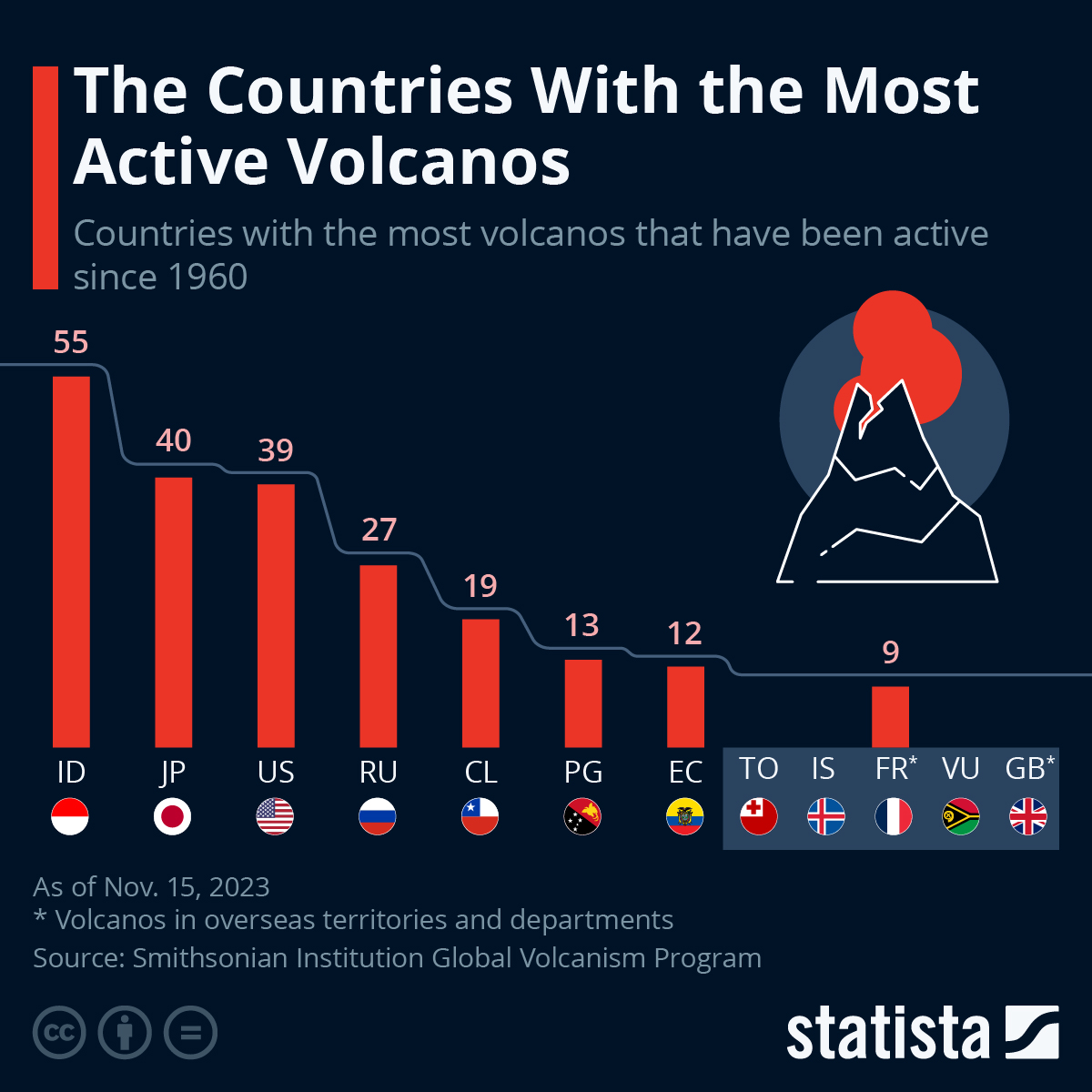
You can see the ring of fire around the Pacific Ocean!
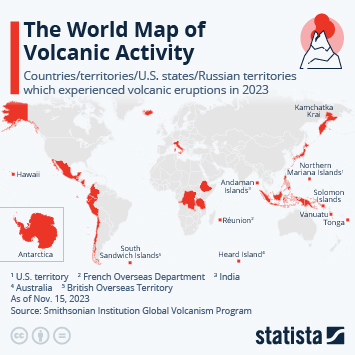
This graph below obliterates the false narrative of a climate crisis that is killing more people.
It's the complete opposite. A climate optimum that's SAVING lives, especially from the 26% increase in global food production, just from the benefit of CO2 on photosynthesis.
Note that droughts and floods, which supposedly are increasing and killing XXX,XXX,Xs of people from the climate crisis.........are not killing as many.
Not despite climate change but BECAUSE OF the beneficial climate change.
Technology obvious is the biggest contributor and the map below is misleading on floods in blue. THERE IS MORE FLOODING because the 1 Deg. C warmer atmosphere and oceans allow the atmosphere to hold 7% more moisture, so clearly that would equate to heavier and more flooding rains. There's no disputing that based on the physical laws of the atmosphere.
Anybody that denies that is a REAL denier.
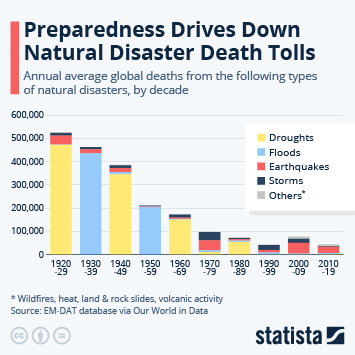
We discuss the timing of volcanic eruptions and quantify atmospheric sulfate loading using an array of ice cores from Greenland and Antarctica. We demonstrate that throughout the Common Era volcanic activity was the main driver for abrupt summer cooling in Europe.
https://pastglobalchanges.org/publications/pages-magazines/pages-magazine/7164
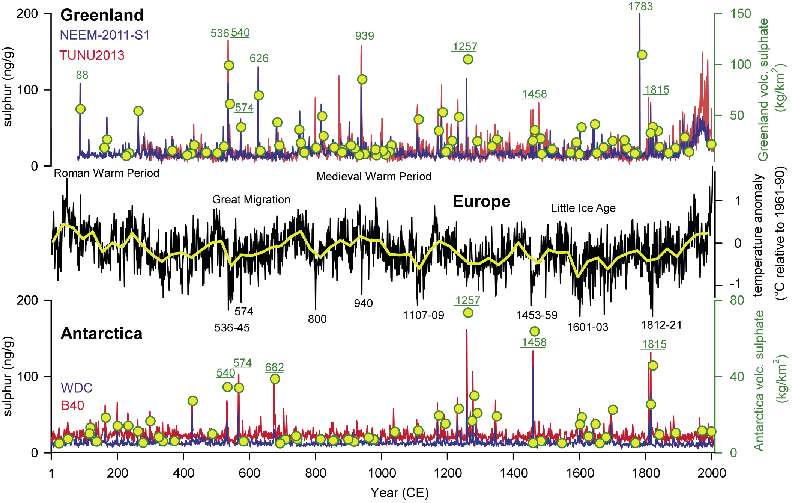
The Global Volcanism Program does not see any evidence that volcanic activity is actually increasing
https://volcano.si.edu/faq/index.cfm?question=historicalactivity
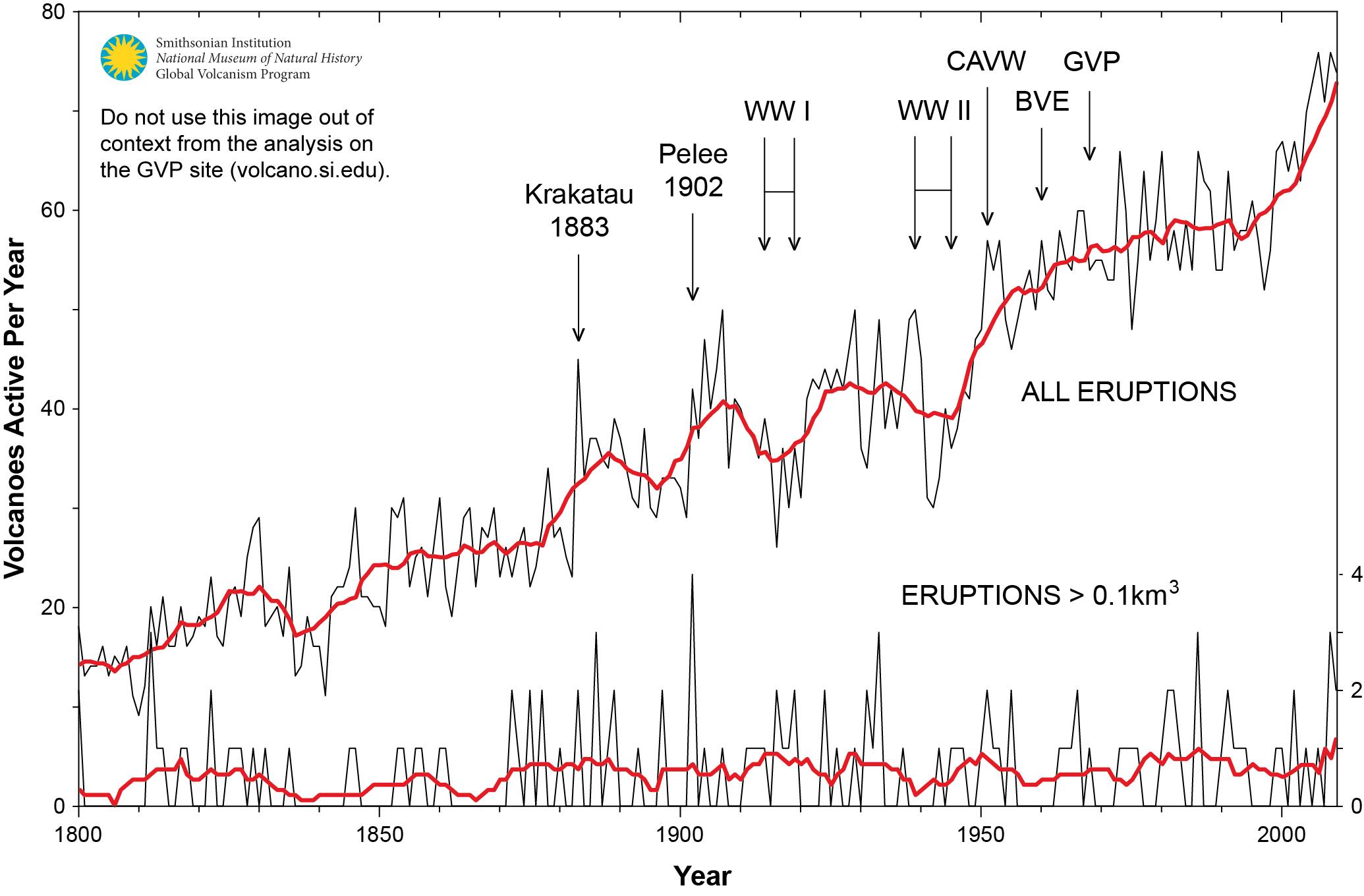
Strong evidence that the historical trend in volcanism is more apparent than real comes from the lower plot of figure 1. Here only the larger eruptions generating at least 0.1 km3 of tephra (VEI >= 4), the fragmental products of explosive eruptions, are plotted. The effects of these larger events are often regional, and therefore less likely to escape documentation even in remote areas. The frequency of these events has remained impressively constant for more than a century, and contrasts strongly with the apparent increase of smaller eruptions with time. The effects of these large eruptions are far reaching and thus they are less likely to escape documentation even in remote areas.
+++++++++++
In other words, improved technology has led to better observations and reporting of EVERYTHING on the planet, including this realm! That's what explains the top part of the graph which is ALL eruptions, including the smaller ones that didn't get recorded in previous years/decades/centuries.
Is a 60,000 ft plum of ash, that gets into the stratosphere, near the equator enough to cause some weather disturbance?
Isn't this what caused the year with no summer?
Maybe this is not enough ash?
EDIT
From your article
With these revised ice-core chronologies, major volcanic eruption dates are in agreement with tree-ring reconstructed cooling extremes that occurred in the immediate aftermath of large volcanic eruptions throughout the Common Era (Fig. 2). The exceptionally cold summers reconstructed in parts of Europe (and other regions) in the years 1816, 1601, 1453, 1109, 574, and 541 CE all followed major volcanic eruptions, thus confirming that volcanic activity is an important driver of natural climate variability on inter-annual timescales. Strong summer cooling is not limited to tropical eruptions but is also observed frequently following eruptions located in the high latitudes of the northern hemisphere, as in the years 940, 800, and 536 CE. The largest volcanic eruption in terms of atmospheric sulfate loading (Samalas, 1257 CE) did not, however, appear to induce strong cooling in Europe. This confirms that for individual eruptions the temperature response to the forcing is spatially heterogeneous and may also be dependent on background conditions of the climate system such as the state of ENSO.
So there are a number of things to consider, that are not reported from Rabaul eruption.
If we had anything remotely close to an eruption that caused "The Year with no Summer" everybody would know about it.
I can't even guess how much ash this one has sent into the stratosphere but it's likely less than1% the amount of Mt. Tambora in 1815(maybe alot less than 1%)
https://scied.ucar.edu/learning-zone/how-climate-works/mount-tambora-and-year-without-summer
The summer of 1816 was not like any summer people could remember. Snow fell in New England. Gloomy, cold rains fell throughout Europe. It was cold and stormy and dark - not at all like typical summer weather. Consequently, 1816 became known in Europe and North America as “The Year Without a Summer.”
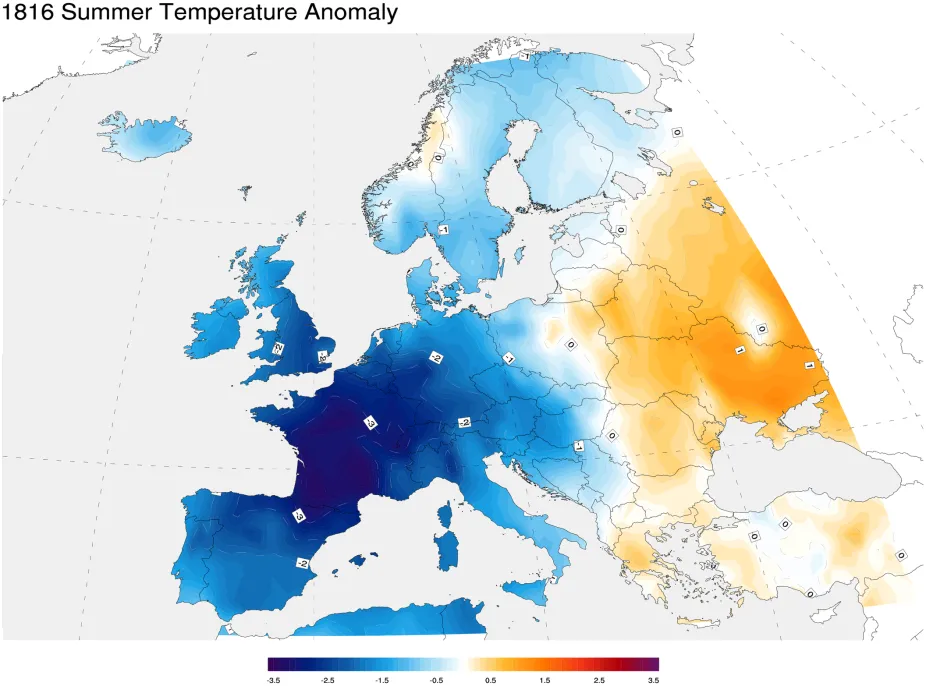
On April 5, 1815, Mount Tambora, a volcano, started to rumble with activity. Over the following four months the volcano exploded - the largest volcanic explosion in recorded history. Many people close to the volcano lost their lives in the event. Mount Tambora ejected so much ash and aerosols into the atmosphere that the sky darkened and the Sun was blocked from view. The large particles spewed by the volcano fell to the ground nearby, covering towns with enough ash to collapse homes. There are reports that several feet of ash was floating on the ocean surface in the region. Ships had to plow through it to get from place to place.
yes I do not think the amount of ash is anything like Mount Tambora. However even the smoke from the wild fires might have had an effect on our crops. I'm thinking of the butterfly theory.
The butterfly effect relates to chaos with a chain reaction that amplifies with time in a closed system with an unchanging balance of radiation/heat coming in vs heat going out.
Individual,systems rapidly change but the amount of radiation/heat forcing doesn’t.
Temporary global cooling from an enormous volcanic eruption completely changes the energy/heat balance with a substantive blocking of some shortwave radiation and warm sunshine getting in that is global and is superimposed on the entire system.
Less global heat gets in, while the mixing in the troposphere of that less heat continues to be redistributed from hot low latitudes to cold high latitudes with butterfly effect weather systems driven by physical laws that attempt to balance the unequal remaining heat in the closed system.
That’s really what weather is. The result of the atmosphere trying to fix the consequence of unequal heating from the sun by generating weather systems that redistribute that heat.
If there was no weather, temperatures would be the same at the same latitudes around the globe and slowly change as the sun angle changed with very little variation
Extremely impressive video, Jean!
Technology is this age is such a wonderful thing that allows us to view so many incredible natural phenomena that people didn't appreciate or even know about previously.
So educational when we apply it with context and use what we learn as viewed with an open, objective mind that can dial in relativity(compared to what we thought we knew and why its different now) vs absoluteness.
In the case of things like small/regional volcanoes and things like tropical storms in the middle of the ocean, 100 years ago, they were happening and sometimes they were not big enough to be documented and recorded.
And only people living right there or close by would know it happened.
Today, ALL THOSE EVENTS are recorded as we have instrumentation and visual devices aimed everywhere, all the time.
When we compare today with what was documented a century ago or more distant past, it appears to indicate a huge increase.
And it is a huge increase..........in our ability to detect and record these things.
However, for major events that had global impacts, we are comparing apples to apples. Even with our less developed technologies, there was enough powerful evidence to record it.
Maybe not with specific measurements of particulate matter or scientific metrics but still, even going back hundreds of years, VISUAL and direct impact descriptions, that include the weather/crops in the year of no Summer over 200 years ago.,
Interesting point on warming the waters.
For this event, it would be extremely localized surrounding the area of eruption.
However, there are an enormous number of volcanoes at the bottom of the ocean, especially in the Pacific.
We know more about the moons surface than we do about some of these areas.
The oceans have over 1,000 times that heat storage of the atmosphere and it takes a tremendous amount of heat, even from a big volcano to heat the ocean.
So even the biggest underwater volcano is speculated to only be capable of heating a small enough area of water as to not make a huge difference in the deep water ocean temperatures.
But it could be more than that. Underwater volcanoes recently discovered under Antarctica are warming the water and melting ice that we didn't appreciate a few decades ago.
WHAT IS THE TEMPERATURE OF LAVA? I WAS TAUGHT THAT LAVA IS STILL WARM IN THE CENTER, FOR 100 YEARS, AFTER IT WAS SPIT OUT OF THE VOLCANO.
ANOTHER FACTOID... COLD WATER IS HEAVIER THAN WARM WATER..